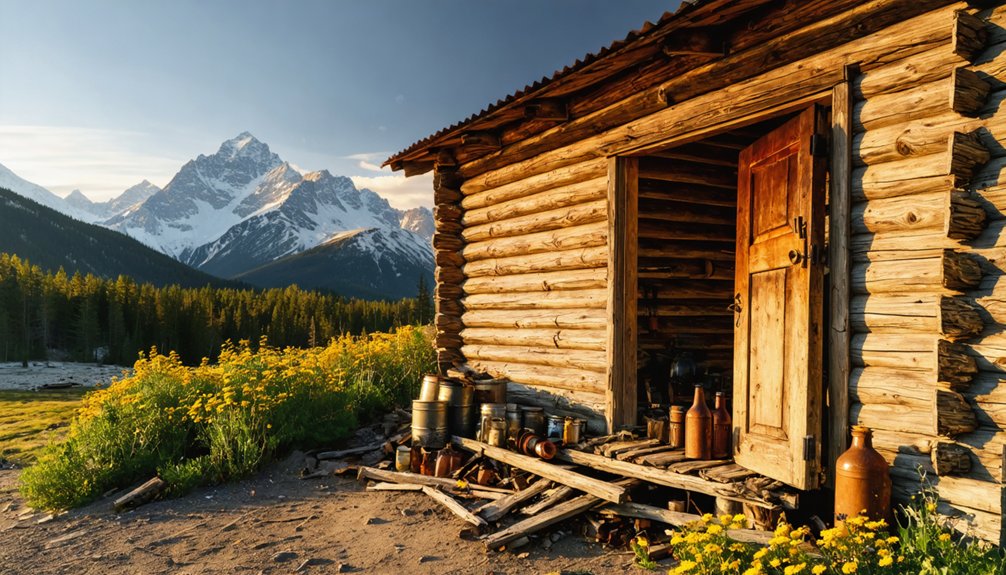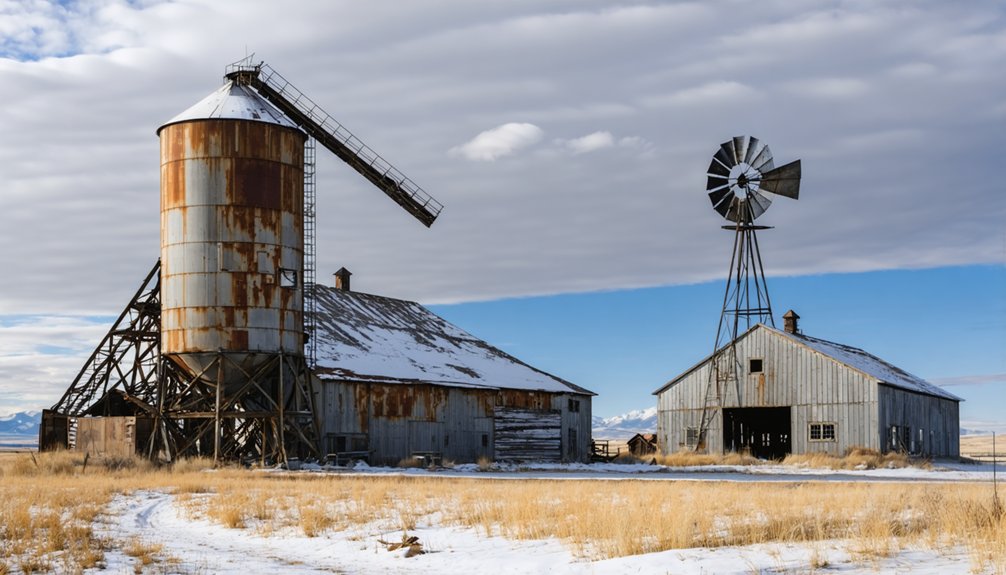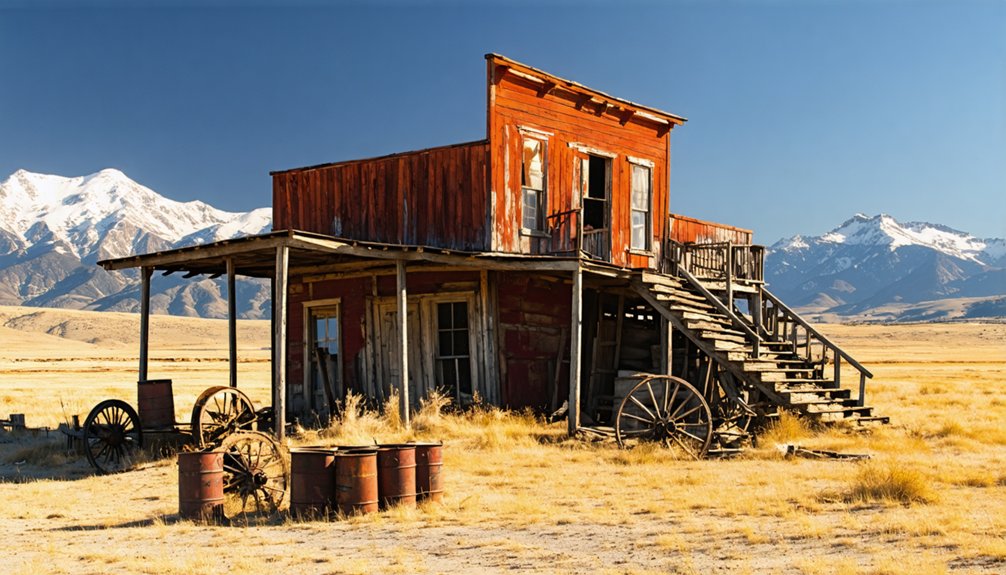McFerran was a short-lived agricultural settlement in El Paso County, Colorado that existed for only seven years (1889-1896). Unlike Colorado’s mining ghost towns, this farming community struggled with high-altitude agriculture, limited growing seasons, and isolation from railways. The silver crash of 1893 and national depression delivered the final blows to its already fragile economy. Today, you’ll find virtually nothing remains, as nature has reclaimed most visible traces of this obscure historical footnote.
Key Takeaways
- McFerran was a short-lived agricultural settlement in El Paso County, Colorado that existed from 1889 to 1896.
- The ghost town site is located along Fourmile Creek to Browns Pass in the eastern foothills of El Paso County.
- Economic challenges, including a national depression and the silver crash of 1893, contributed to McFerran’s rapid abandonment.
- Environmental factors like high-altitude terrain, limited growing seasons, and soil contamination from nearby mining made farming unsustainable.
- Today, minimal structural remains exist at the site, with natural reclamation erasing most visible traces of the settlement.
The Brief Agricultural Legacy of McFerran (1889-1896)
The short-lived agricultural community of McFerran represents one of Colorado’s more enigmatic frontier settlements, leaving barely a trace in El Paso County’s historical record.
This obscure outpost emerged during Colorado’s agricultural expansion period, though concrete details remain elusive to modern researchers.
The settlement’s agricultural practices likely mirrored those of neighboring frontier communities, adapting eastern farming techniques to Colorado’s arid climate and challenging terrain.
Settlement patterns would have followed typical homesteading arrangements, with families establishing scattered properties connected by primitive roads.
Without access to county archives, agricultural census data, or local newspaper accounts from 1889-1896, McFerran’s specific contributions to El Paso County’s development remain shrouded in historical mystery.
Similar to how Officers’ Reserve Corps documented their members with detailed addresses, McFerran residents’ locations would have been recorded in now-lost town registries.
Local horse breeding may have included the introduction of Morgan horses that were popular for their sturdy build and versatility on frontier farms.
For those seeking to understand this forgotten chapter in Colorado’s frontier history, specialized historical sources await exploration.
Geographic Setting in El Paso County
You’ll find McFerran nestled within El Paso County‘s eastern foothills region, specifically positioned along the strategic corridor connecting Fourmile Creek to Browns Pass.
This agricultural settlement occupied a shifting zone where the county’s varied terrain created uniquely favorable conditions for farming operations during the late 19th century.
The site’s specific geographic placement within El Paso County’s broader agricultural landscape explains both its brief flourishing and ultimate abandonment as regional farming economies shifted. Similar to what happened in towns like Garo, McFerran faced economic challenges when transportation routes changed, leaving once-prosperous agricultural communities isolated from vital markets. Like many other farming towns throughout Colorado, McFerran was eventually deserted due to the widespread phenomenon of rural depopulation.
Precise County Location
Nestled within the expanse of El Paso County, Colorado, McFerran’s geographic positioning carries historical significance along the county’s eastern boundary.
The settlement sits precisely on the border between El Paso and Lincoln counties, marking a distinctive geographic threshold that defined its development and ultimate fate.
You’ll find this farming community‘s location documented in Colorado’s extensive ghost town registry, with specific coordinates preserved in El Paso County’s historical settlement records.
The site connects to the broader region via seasonal roads linking the Fourmile Creek area and Browns Pass, though accessibility remains limited by terrain and weather conditions.
Unlike Colorado’s numerous mining ghost towns, McFerran’s position within El Paso County reflects its agricultural heritage, distinguishing it within the state’s historical geographic boundaries.
Many ghost town explorers should download maps before visiting, as McFerran represents one of over fifty towns available for exploration in Colorado’s historical landscape.
Visitors are encouraged to respect the preservation of sites and leave these historical areas as they found them when exploring this unique abandoned settlement.
Regional Agricultural Context
McFerran’s agricultural significance stems directly from its strategic position within El Paso County’s diverse farming landscape.
You’ll find that the settlement existed within a regional economy where corn dominated the Fountain Creek area in the 1860s, later giving way to wheat as a secondary grain crop. By 1900, potato cultivation had spread through nearby Calhan, eventually superseded by beans around 1915.
The settlement’s crop diversification strategies necessarily responded to environmental challenges including devastating grasshopper plagues and limited rainfall averaging just 15 inches annually. Agricultural efforts were further complicated by severe drought conditions and early frost that ravaged crops in 1888.
Livestock management practices centered on cattle ranching that flourished on eastern prairie lands, while sheep operations established footholds in the Huerfano Valley.
These agricultural patterns created a distinct regional identity, with McFerran positioned within El Paso County’s shift zone between mountainous west and prairie east. The area’s farmers and ranchers regularly participated in agricultural exhibitions at the annual Fair in Calhan that began as a Thanksgiving festival for potato harvest in 1905.
Economic Challenges of Farming-Based Settlement
While attempting to establish agricultural roots in Colorado’s challenging terrain, settlers of McFerran quickly encountered a perfect storm of economic obstacles that ultimately doomed their farming venture.
You’d have found yourself caught between nature’s constraints and market realities—the short growing seasons and unpredictable weather patterns undermined farming sustainability before you could establish financial footing.
Without adequate transportation infrastructure, your crops couldn’t reach profitable markets, leaving you isolated from potential buyers.
When you did manage to harvest, fluctuating commodity prices eroded your income stability.
The absence of financial institutions limited your access to capital for improvements or surviving lean years.
Meanwhile, competing against more productive agricultural regions with better soil and water access made your economic position increasingly untenable—explaining McFerran’s brief seven-year existence.
Similar to Dearfield’s struggles during the Great Depression and Dust Bowl, McFerran residents faced devastating environmental challenges that accelerated the town’s abandonment.
Much like the mining settlement of Tincup founded in 1859, McFerran residents struggled to create stable livelihoods in Colorado’s harsh and unforgiving landscape.
Daily Life in a Small Colorado Agricultural Community
Despite the economic challenges that ultimately doomed McFerran, daily life in this small agricultural community reflected the typical rhythms and structures of late 19th-century Colorado farming settlements.
You’d have risen with the sun to tend crops like corn, wheat, and the region’s famously sweet melons, managing irrigation ditches that transformed the arid landscape.
Your family would’ve been your primary workforce, with children assigned age-appropriate chores from tending honeybees to helping with harvest.
Between labor-intensive seasons, community gatherings and seasonal festivals like Melon Day provided rare social respite.
The semi-cooperative structure of these colonies meant you’d likely belong to ditch companies and other resource-sharing organizations.
Evening activities centered around your homestead after days spent battling Colorado’s dramatic temperature fluctuations, which paradoxically yielded exceptionally flavorful produce.
Factors Behind McFerran’s Abandonment

You’ll find McFerran’s swift decline from 1889 to 1896 stemmed primarily from economic fragility, as the farming settlement lacked diversification during the 1890s national depression.
The environmental challenges of Colorado plains agriculture further undermined the community’s viability, with unpredictable weather patterns and possible soil depletion accelerating its downfall.
Perhaps most critically, McFerran’s exclusion from developing railroad networks isolated the settlement from broader markets, creating a competitive disadvantage compared to better-connected agricultural communities in the region.
Economic Failure Circumstances
When examining McFerran’s economic collapse, multiple interconnected factors created a perfect storm of financial devastation that ultimately led to the town’s abandonment. The town’s reliance on mining proved fatal as ore veins depleted and extraction costs soared. The silver crash of 1893 delivered a crushing blow, triggering widespread economic instability throughout the region.
Unlike more resilient communities, McFerran failed to diversify beyond its mining and agricultural foundations. You can see how this monocultural economy left residents particularly vulnerable when the mining decline accelerated.
Without railroad connections or improved roadways, the town remained isolated from potential markets and investment opportunities. This transportation deficit, combined with the exodus of workers seeking stability elsewhere, created an irreversible downward spiral that sealed McFerran’s fate as another casualty of boom-and-bust economics.
Environmental Farming Challenges
The environmental challenges that plagued McFerran’s farming community contributed considerably to the town’s eventual abandonment.
You would’ve faced insurmountable obstacles trying to sustain agriculture amid severe environmental degradation. Mining operations contaminated soil and water with toxic heavy metals, while acid mine drainage rendered water sources unusable for crops and livestock.
The high-altitude terrain offered minimal arable land, compounded by harsh climatic conditions that severely limited growing seasons.
When you’d try to farm, the 8 million tons of mine waste would’ve destroyed soil fertility, while groundwater pollution made irrigation hazardous. The economic burden of maintaining farming sustainability became impossible as tailings and waste rock consumed potential farmland, leaving previously cultivated areas barren.
These combined factors made agricultural pursuits increasingly futile, accelerating McFerran’s decline.
Railroad Route Exclusion
Despite McFerran’s initial promise as a settlement, its exclusion from major railroad routes proved fatal to its long-term viability.
You can trace this failure to the economic priorities that governed railroad competition in Colorado’s challenging terrain. Railroad companies systematically bypassed McFerran in favor of more profitable settlements with valuable mineral deposits or larger commercial markets.
The town’s mountainous location presented prohibitive operational costs, particularly for snow removal which could consume up to 41% of railroad budgets.
Strategic routing decisions favored tunnels like Moffat (completed 1927) that offered more direct connections between major economic hubs.
Unlike resource-rich towns such as Silverton or Leadville, McFerran lacked the political influence or economic leverage needed to secure railroad access, ultimately sealing its fate as commerce flowed elsewhere.
What Remains Today: Site Condition Assessment

Vanishing traces of McFerran’s brief existence characterize the ghost town site today, with minimal structural remains setting it apart from Colorado’s better-preserved abandoned settlements.
Unlike neighboring ghost towns with standing buildings or visible ruins, McFerran offers virtually no site visibility, having succumbed to natural reclamation after its short 1889-1896 farming community lifespan.
McFerran stands as a ghost among ghosts, erased by time where even its neighboring abandoned settlements still speak.
Archaeological evidence is scarce, with no documented household artifacts, machinery, or typical ghost town debris.
You’ll find no interpretive signage, monuments, or formal access points designating the location. The area likely remains in private hands or agricultural use, explaining its obscurity compared to tourism-oriented ghost towns nearby.
Without official preservation efforts or historical society focus, McFerran exists primarily through historical listings rather than physical remnants—a ghost town that has nearly completely vanished.
McFerran’s Place Among Colorado’s Ghost Towns
While mining towns primarily dominate Colorado’s ghost town landscape, McFerran stands apart as a rare agricultural settlement that briefly flourished between 1889-1896.
Positioned in El Paso County’s farming territory, it represented an alternative economic model during Colorado’s mining-centric expansion era.
Unlike mining settlements with their impressive infrastructure and population densities, farming communities like McFerran demonstrated less resilience against economic pressures.
In ghost town comparisons, McFerran belongs to a smaller category within Colorado’s abandoned settlement taxonomy:
- Existed alongside other El Paso County ghost towns like Howbert and Husted
- Operated for only seven years versus decades-long mining operations
- Lacked the economic diversification of mining centers like Gilman or Tomboy
- Represented the minority classification in Colorado’s primarily mining-based abandonment pattern
Documenting a Forgotten Agricultural Experiment

Piecing together McFerran’s agricultural history presents significant challenges for contemporary researchers, as only fragmentary evidence remains of what was once an ambitious farming experiment.
The absence of thorough documentation creates a historical void that you’ll need to navigate through alternative sources.
To uncover McFerran’s agricultural story, you might explore county land records, university agricultural extension archives, or personal accounts from descendants of early settlers.
These could reveal details about the experimental crops and innovative agricultural techniques attempted in this harsh Colorado environment.
The freedom to investigate beyond conventional historical narratives opens possibilities for reconstructing this forgotten chapter.
Consider reaching out to local historical societies, searching newspaper archives, or examining aerial photography that might reveal field patterns unique to experimental farming methods once practiced in McFerran’s now-empty landscape.
Frequently Asked Questions
Are There Any Surviving Photographs of Mcferran?
Based on historic documentation and visual archives research, you won’t find verified surviving photographs of McFerran. Its status as a farming community, not a mining town, contributed to this documentation gap.
Did Any Notable Historical Figures Visit Mcferran?
No documented evidence exists of notable historical figures visiting McFerran. The town’s limited historical significance as a small farming settlement likely didn’t attract visitors of prominence during its brief existence.
What Crops Were Primarily Grown in Mcferran?
Think you’re special asking about peasant farming? You’d have grown corn as the primary crop, with wheat production trailing second. Farmers practiced crop rotation with oats, barley, and later sugar beets.
Were There Indigenous Communities Near Mcferran Before Settlement?
Yes, Ute tribes primarily inhabited the area before McFerran’s establishment. You’ll find their indigenous history and tribal significance reflected in archaeological evidence throughout the region’s pre-settlement landscape.
Has Mcferran Been Featured in Any Movies or Literature?
Out of sight, out of mind. You’ll find no film adaptations or major literary references of McFerran. Its brief agricultural history and remote location have kept it neglected in cultural representations.
References
- https://www.denver7.com/news/local-news/colorado-ghost-towns-their-past-present-and-future-in-the-rocky-mountains
- https://kids.kiddle.co/List_of_ghost_towns_in_Colorado
- https://en.wikipedia.org/wiki/List_of_ghost_towns_in_Colorado
- https://www.coloradolifemagazine.com/printpage/post/index/id/172
- https://www.altaonline.com/dispatches/a6466/ghost-town-wild-west-laura-fraser/
- https://www.colorado.com/articles/colorado-ghost-towns
- https://ghosttownmuseum.com/our-story/
- https://www.youtube.com/watch?v=CCXuJJiQDfA
- https://spl.cde.state.co.us/artemis/hedmonos/hed62c711927internet/hed62c711927vol4internet.pdf
- https://archive.org/stream/officiallistoff00deptgoog/officiallistoff00deptgoog_djvu.txt



